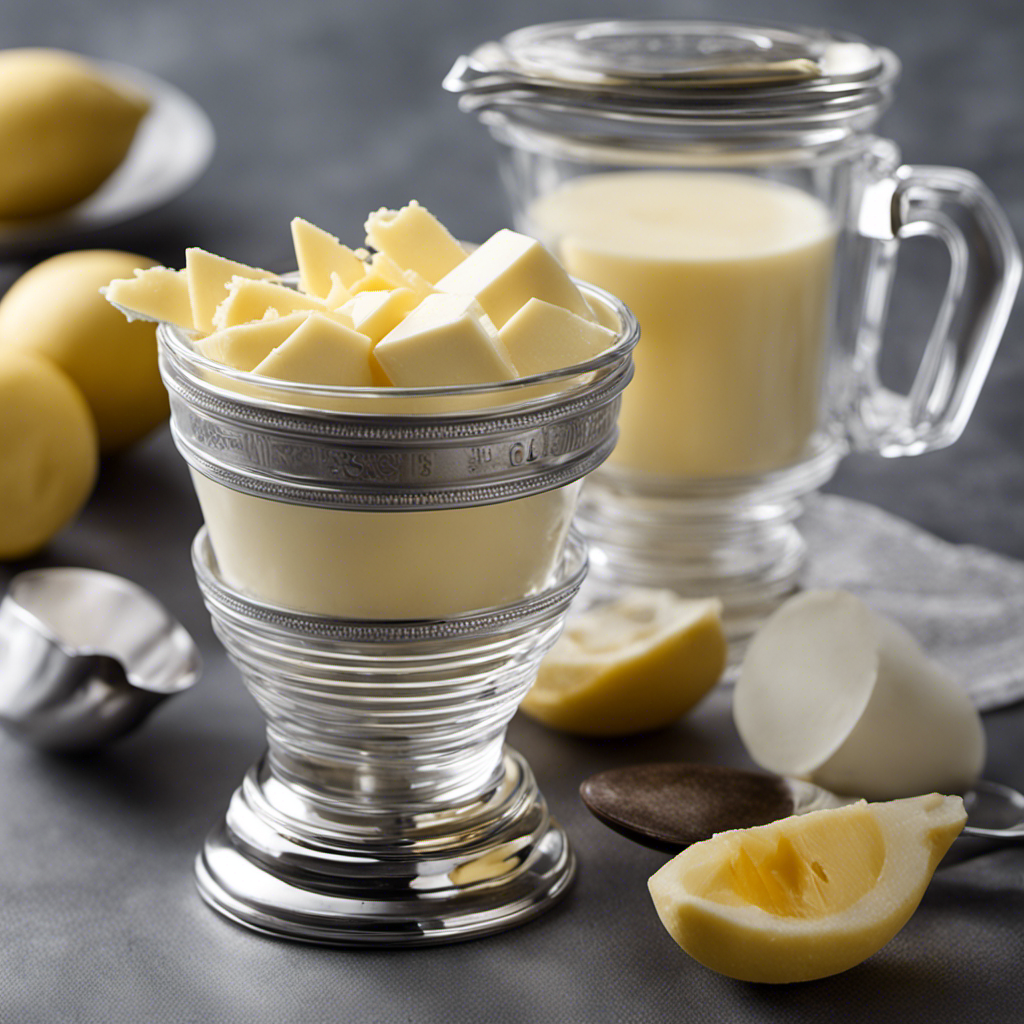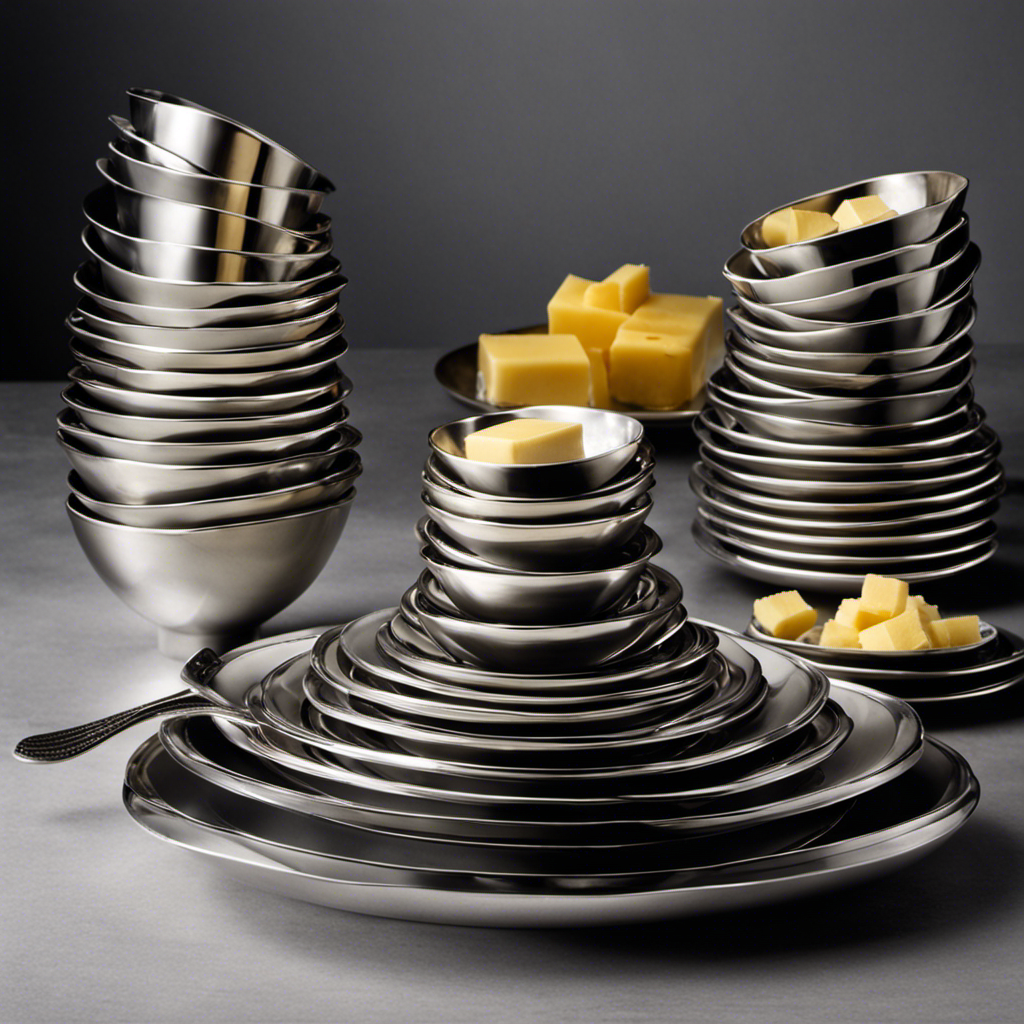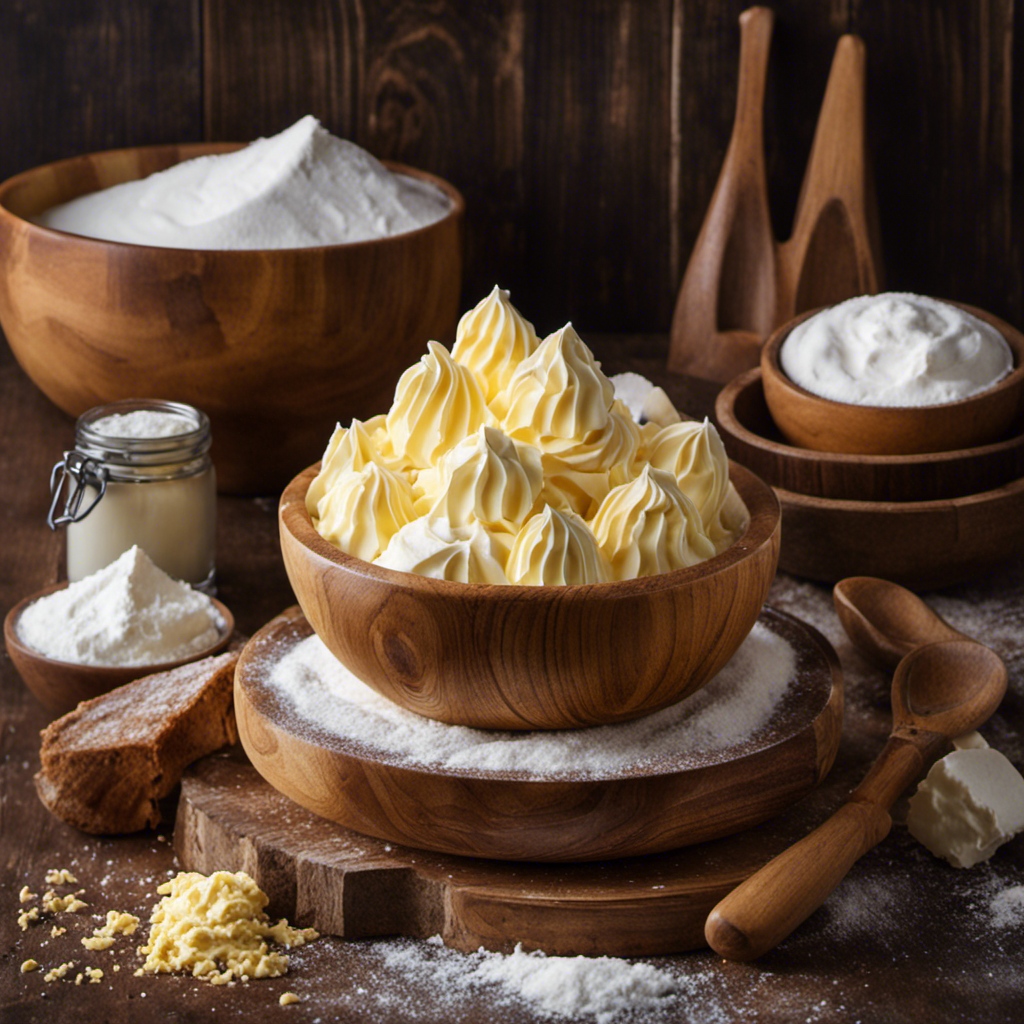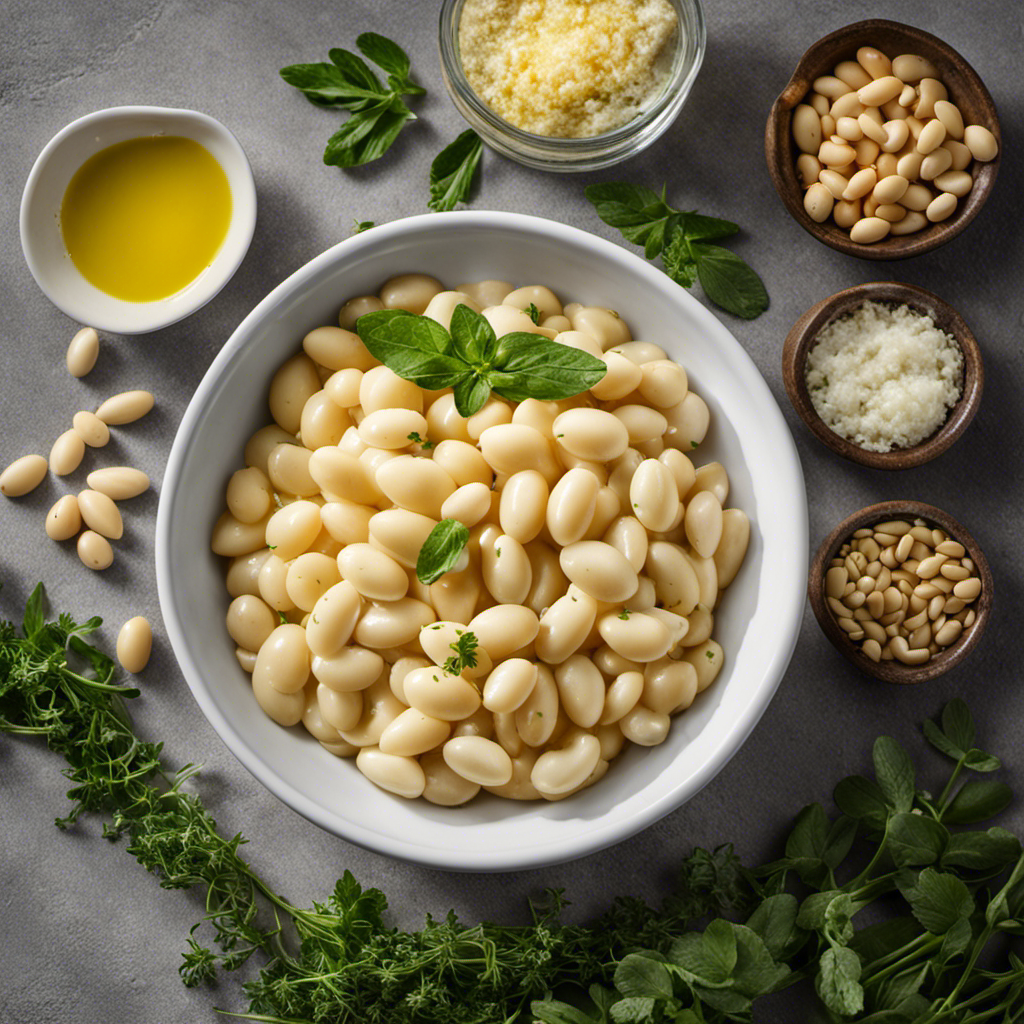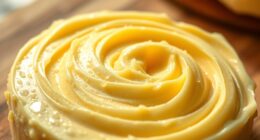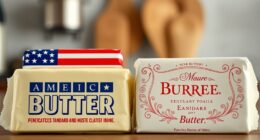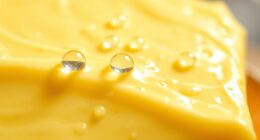Do you ever find yourself in the kitchen, pondering the conversion of 2/3 cups of butter into tablespoons? Well, wonder no more as I have the answer for you!
In this informative article, we’ll break down the conversion process step by step, so you’ll never have to guess again. From understanding the measurement conversion to the math behind it, we’ll cover it all.
So grab your measuring cup and get ready to become a butter-measuring pro!
Key Takeaways
- Precise measurements are crucial in baking and cooking, as even a slight variation in ingredient amounts can affect the final outcome of a recipe.
- Converting cups to tablespoons is essential for accurate ingredient quantities, and the conversion ratio for cups to tablespoons is 16:1.
- Proper measuring techniques, including using the appropriate measuring cups and spoons for dry and liquid ingredients, ensure accurate results.
- When measuring butter, it is important to soften it before measuring, pay attention to measurement lines on butter wrappers, and avoid overpacking the measuring spoon.
Understanding the Measurement Conversion
There’s a simple way to convert measurements, like tablespoons to cups.
When it comes to baking or cooking, precise measurements are of utmost importance. Even a slight variation in the amount of an ingredient can affect the final outcome of a recipe. This is especially true when it comes to butter, as its consistency can greatly impact the final result.
For example, using softened butter versus melted butter can affect the texture and structure of baked goods. It’s important to follow the recipe’s instructions regarding butter consistency to achieve the desired outcome.
Understanding the impact of different butter consistencies and the importance of precise measurements will help ensure that your recipes turn out perfectly every time.
The Basic Conversion Ratio
To convert 2/3 cups of butter into tablespoons, you’ll need to multiply it by 16.
This conversion process is crucial in the culinary world, where precise measurements are essential for successful recipes. Understanding the conversion process allows chefs and home cooks to accurately adjust their ingredient quantities and achieve the desired results.
When it comes to practical applications of this conversion, it is commonly used when scaling down or up recipes. For instance, if a recipe calls for 1 cup of butter but you only have 2/3 cups, multiplying it by 16 will give you the equivalent in tablespoons.
This enables you to maintain the correct ratio of butter in your dish, ensuring its flavor and texture remain consistent.
Converting Cups to Tablespoons
When it comes to converting cups to tablespoons, it’s important to understand the conversion ratio. The conversion ratio for cups to tablespoons is 16:1, meaning there are 16 tablespoons in one cup.
To calculate the number of tablespoons from cups, simply multiply the number of cups by 16.
Conversion Ratio for Cups to Tablespoons
You can easily convert cups to tablespoons by multiplying the number of cups by 16.
Understanding the conversion process is important when it comes to precise measurements in cooking and baking.
Converting cups to tablespoons allows for accurate and consistent results in recipes.
By knowing the conversion ratio of 1 cup to 16 tablespoons, you can easily adjust measurements based on your needs.
This is especially useful when scaling recipes up or down.
It is crucial to have precise measurements in order to achieve the desired outcome in your dishes.
Whether you are measuring liquids or dry ingredients, using the correct conversion ratio ensures that you are adding the right amount of each ingredient.
Now that we understand the conversion process for cups to tablespoons, let’s move on to calculating tablespoons from cups.
Calculating Tablespoons From Cups
Once you have the number of cups you need, all you have to do is multiply it by 16 to calculate the corresponding number of tablespoons.
Understanding measurement units is essential when it comes to cooking and baking. Here are four different types of butter measurements and their equivalent tablespoons:
- 1/4 cup of butter = 4 tablespoons
- 1/2 cup of butter = 8 tablespoons
- 2/3 cup of butter = 10 and 2/3 tablespoons
- 1 cup of butter = 16 tablespoons
How to Convert 2/3 Cups to Tablespoons
To convert 2/3 cups to tablespoons, simply multiply the measurement by 16. This is a common conversion technique used when working with measuring utensils in the kitchen. When cooking or baking, it’s important to have precise measurements to ensure the desired outcome of your recipe. Here is a table that shows the conversion of different measurements from cups to tablespoons:
| Cups | Tablespoons |
|---|---|
| 1/4 | 4 |
| 1/3 | 5.33 |
| 1/2 | 8 |
| 2/3 | 10.67 |
As you can see, 2/3 cups is equal to approximately 10.67 tablespoons. Understanding these conversions allows you to accurately measure ingredients and achieve the desired taste and texture in your dishes. Now, let’s dive into the math behind the conversion and understand how it works.
The Math Behind the Conversion
Understanding the math behind the conversion helps you accurately measure ingredients and achieve the desired taste and texture in your dishes. Here’s a breakdown of how to convert ounces to tablespoons:
-
Know the conversion factor: 1 fluid ounce is equal to 2 tablespoons.
-
Determine the number of ounces in your measurement. For example, if you have 16 ounces, divide it by 2 to get the number of tablespoons.
-
Simplify any fractions. If you have a fraction like 2/3, multiply the numerator (2) by the conversion factor (2 tablespoons per ounce) and divide it by the denominator (3).
-
Calculate the final result. In our example, 2/3 cups of butter would be equal to approximately 10 and 2/3 tablespoons.
Using a Measuring Cup for Accuracy
When it comes to cooking and baking, proper measuring techniques are essential for achieving accurate and consistent results.
Using a measuring cup allows me to precisely measure ingredients and ensure that I am following the recipe correctly.
Consistency in measuring is important because even a slight variation in the amount of ingredients can greatly affect the outcome of the dish.
Proper Measuring Techniques
Make sure you’re using the correct measuring cups and spoons when measuring ingredients like butter. Proper measuring techniques are essential for accurate and consistent results in your cooking and baking.
Here are four key tips to ensure you’re measuring accurately:
-
Use dry measuring cups for dry ingredients like flour and sugar. These cups have straight sides and a flat top for easy leveling.
-
Use liquid measuring cups for liquids like milk and oil. These cups have a spout for pouring and are marked with graduated lines for precise measurements.
-
Spoon dry ingredients into the measuring cup and level off with a straight edge. Don’t pack the ingredients down, as this can lead to too much being used.
-
For smaller measurements, use measuring spoons. These come in various sizes and are perfect for precise amounts of spices and flavorings.
Importance of Consistency
To achieve the best results in your cooking and baking, it’s important that you maintain consistency in your measuring techniques. Precision plays a crucial role in the success of your recipes. Even a small variation in measurements can have a significant impact on the outcome of your dish.
Inconsistent measurements can lead to a cake that doesn’t rise properly or cookies that spread too thin. Accuracy is key when it comes to achieving the desired texture and flavor. By using the same measuring tools and techniques each time you cook or bake, you can ensure that your recipes turn out just right.
Speaking of measurements, let’s now discuss how to convert other measurements of butter.
Converting Other Measurements of Butter
There’s a simple way to convert other measurements of butter. When it comes to measuring butter accurately, it’s important to know the common conversions. Here are four common conversions for butter:
- 1 stick of butter = 8 tablespoons
- 1/2 cup of butter = 1 stick
- 1/4 cup of butter = 4 tablespoons
- 1 tablespoon of butter = 1/2 ounce
Knowing these conversions can help you accurately measure butter for your recipes. It’s helpful to have this knowledge on hand, especially when you come across a recipe that calls for a different measurement than what you have on hand. With these conversions, you can easily adjust the amount of butter needed.
Now that you know how to convert other measurements of butter, let’s move on to some tips and tricks for measuring butter accurately.
Tips and Tricks for Measuring Butter
One important tip for accurately measuring butter is to soften it before measuring. This allows for easier scooping and ensures a more accurate measurement. Different types of butter can have varying densities, so it’s important to take this into consideration when measuring. Here are some alternative methods for measuring butter without a measuring cup:
| Method | Measurement Equivalent |
|---|---|
| Using a Tablespoon | 1 tablespoon |
| Using a Kitchen Scale | grams or ounces |
| Using a Butter Mold | pre-measured markings |
| Using a Stick Butter Wrapper | pre-marked tablespoons |
These methods can be useful when you don’t have a measuring cup on hand or if you prefer more precise measurements. Now, let’s move on to the next section about common mistakes to avoid when measuring butter.
Common Mistakes to Avoid When Measuring Butter
Make sure you don’t overpack the measuring spoon when measuring softened butter, as this can lead to inaccurate measurements.
Here are some common misconceptions about measuring butter accurately:
-
Using a liquid measuring cup: Butter should be measured using dry measuring cups, as liquid measuring cups are designed for liquids and can result in inaccurate measurements.
-
Cutting butter with a knife: Instead of cutting butter with a knife, it is best to use a butter knife or a spoon to transfer the butter into the measuring cup. This ensures a more accurate measurement.
-
Measuring cold butter: When a recipe calls for softened butter, it is important to measure it after it has been softened. Measuring cold butter can lead to inaccurate measurements and affect the texture of your baked goods.
-
Ignoring the measurement lines on the wrapper: Many butter wrappers have measurement lines printed on them, making it easy to measure the required amount. Ignoring these lines can result in inaccurate measurements.
Frequently Asked Questions
Can I Use Margarine Instead of Butter When Measuring 2/3 Cups?
Sure, you can use margarine instead of butter when measuring 2/3 cups. However, keep in mind that margarine might alter the taste of your dish compared to using butter.
How Do I Convert Tablespoons to Grams?
Converting tablespoons to milliliters is simple. Just remember that 1 tablespoon is equivalent to 15 milliliters. When it comes to converting grams to ounces, 1 gram is equal to 0.035 ounces.
What Is the Difference Between Salted and Unsalted Butter in Terms of Measurement?
In terms of taste, the main difference between salted and unsalted butter is the presence of salt. Salted butter has salt added, while unsalted butter does not. As for substituting margarine for butter in baking recipes, it is possible, but the results may vary.
How Many Sticks of Butter Are in 2/3 Cups?
In 2/3 cups of butter, there are approximately 10 and 2/3 tablespoons. It’s important to know this measurement for recipes or when trying to soften butter quickly. Some substitutes for butter include margarine or oil.
Can I Use a Digital Scale Instead of Measuring Cups for Accuracy?
Yes, you can use a digital scale for measuring butter. It provides accuracy in ingredient measurement. Using a digital scale ensures precision and eliminates the need for measuring cups, making it convenient and reliable.
Conclusion
In conclusion, measuring butter can be a piece of cake once you understand the conversion ratios. By knowing that there are 16 tablespoons in a cup, you can easily convert 2/3 cups to tablespoons. Just multiply 2/3 by 16, which equals about 10 and 2/3 tablespoons.
Remember, using a measuring cup ensures accuracy in your baking endeavors. So, don’t let measuring butter be a slippery slope, follow these tips and tricks to avoid common mistakes.
Happy baking!
